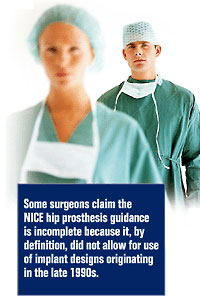Surgeons question efficacy of NICE guidances
To ensure it is current, U.K. health officials are expected to review the recent hip prosthesis guidance again this year.
 Some physicians and medical groups in the United Kingdom are criticizing verbally, and in print, recent health care guidances issued by the National Institute for Clinical Excellence on a number of medical treatments.
Some physicians and medical groups in the United Kingdom are criticizing verbally, and in print, recent health care guidances issued by the National Institute for Clinical Excellence on a number of medical treatments.
The British Department of Health set up the National Institute for Clinical Excellence (NICE) in 1999 to advise national regulatory authorities in England and Wales. Since 2000, NICE has issued about 100 such guidances to be implemented by British and Welsh NHS sites.
Critics of the recent guidances called them inadequate in some cases because they do not reflect current practices or research. Other NICE guidances came under fire for not being fully based upon evidence-based medicine.
The most significant criticism came in a widely publicized study in the British Medical Journal in October, which attempted to document whether NICE guidances were being implemented. Researchers said that prescription patterns for some medications, such as the drugs used for Alzheimer’s disease, may have been affected by the new NICE guidlines, but they found no definitive evidence to prove it.
Elsewhere the researchers found no apparent changes in medical practice despite NICE directives. Hip prostheses offered one clear example where the guidelines apparently went ignored, according to the study. Widespread loosening problems with the 3M Capital hip implant used in the United Kingdom in the mid- to late-1990s caused NICE to establish guidelines for the selection of hip prostheses.
|
|
In the April 2000 NICE guidance, the institute recommended that surgeons use prostheses for total hip replacement that either have a demonstrable replacement rate of 10% or less at 10 years, or a minimum of three years, provided their performance is consistent with the 10-year benchmark. Only 69% of prostheses used from 1998 to 2002 met the 10-year benchmark, for example.
The first review of that guidance came in April 2003 and another is scheduled for this year.
At the same time, other guidances are being well received. Orthopaedics Today medical editor David L. Hamblen, PhD, FRCS, of Glasgow, said he was pleased and not at all surprised by NICE’s recent statement on using minimally invasive surgery (MIS) to perform total joint replacements (TJR), issued in October. According to the statement from the NICE Interventional Procedures Advisory Committee (IPAC), which contained only provisional recommendations for using MIS TJR in special cases, the complication and revision rates with the new technique were simply too high to warrant regular use of the technique.
IPAC cited revision rates of 2.3% with MIS total knee replacement in a 166-case series, the largest one they looked at, and complication rates of 4.5% and 15% in two smaller series. Similarly, poor results with MIS total hip replacement led IPAC officials to advise against using that technology as well.
Hamblen told Orthopaedics Today this guidance “might do something to stem the commercial pressures to put everything in through ‘keyholes.’” He supported the NICE consultation document on MIS TJR because there is “no medium-term data to back it up.”
Increased exposure
There is growing concern among orthopaedic surgeons in the United Kingdom about being charged with negligent medical practice in a court of law should NICE guidelines for hip prostheses and other devices and procedures not be followed closely. An editorial in the Feb. 20 British Medical Journal by orthopaedic surgeons at Weston General Hospital in Weston-super-Mare, England, addressed this and other areas.
They wrote, “A spirit of cooperation with NICE is probably the best way forward for doctors and law makers alike. NICE guidelines, however, have areas of uncertainty. These include a lack of specific information on the acetabular component in published guidelines; lack of clarity on hybrid variants — either in the form of cementless and cemented technology combined — or in relation to cup and stem from different manufacturers; and the place of generic copies of original designs.”
The authors called the hip prosthesis guidance incomplete because it, by definition, did not allow for use of implant designs originating in the late 1990s.
Facing daunting challenges
In defense of NICE, George Bentley, DSc, ChM, FRCS, director and professor of orthopaedics at Royal National Orthopaedic Hospital Trust in Stanmore, England, said, “NICE has an almost impossible task since it is charged with advising and at the same time avoiding overspending.”
Bentley, a member of the Orthopaedics Today Editorial Board, said in a letter to Orthopaedics Today that his experiences with NICE have been positive: “There is a genuine attempt to reach a sensible conclusion, and also a compassionate conclusion, from the point of view of the patients.”
NICE issued its most recent orthopaedic guidance — on the prevention of secondary osteoporotic fractures in postmenopausal women — in January. A guidance on preventing primary osteoporotic fractures in postmenopausal women is due in September.
To view NICE musculoskeletal guidances, go to www.nice.org.uk/page.aspx?o=91524.

